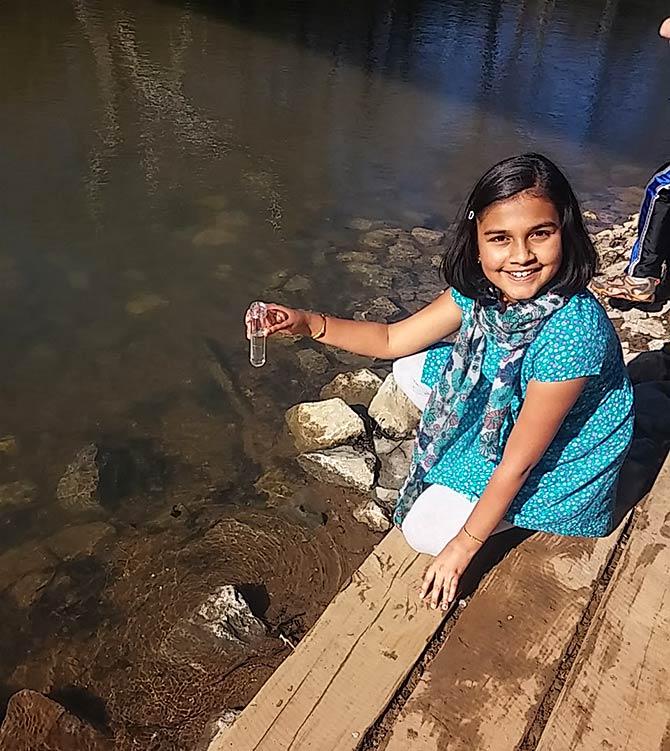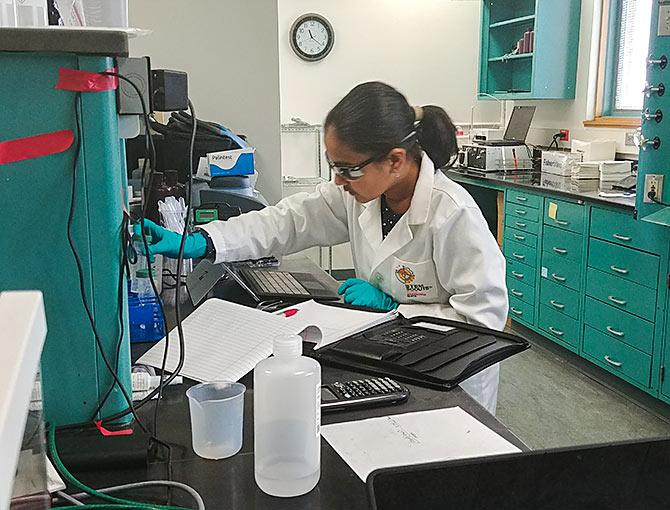'We don't know if the water we are drinking has lead in it or not.'
'In India, we don't have ways to easily detect or measure contamination levels.'

The 12 year old has invented Tethys, a low-cost device that helps detect lead contaminated water. Photographs: Kind courtesy Gitanjali Rao
What would you do if you knew that the water you consume every day is contaminated?
Gitanjali Rao was 9 years old when she read about the Flint water crisis in the United States in 2015.
Forty per cent homes in Flint, Michigan, had been receiving contaminated water with dangerously high levels of lead.
While reading about lead contamination in water, Gitanjali who admires Marie Curie, realised how the process to detect lead in water was lengthy, cumbersome and faulty.
"Today, there are two main solutions to be able to detect for lead in your water, but they are too cumbersome, expensive, and take a lot of time. They don't look at detection, accuracy, and contamination levels together," the seventh grader who studies at the STEM School Highlands Ranch in Colorado, USA, tells Divya Nair/Rediff.com.
Gitanjali's desire to find solutions led her to design Tethys, a portable invention that would make water testing a simpler process.
The device which uses carbon nanotubes to detect the presence of lead enables a sensor linked to a mobile app to give an accurate, almost immediate, analysis via a mobile app.
In 2017, Gitanjali won the Discovery Education 3M Young Scientist Challenge for inventing a quick, low-cost test to detect lead-contaminated water.
What were your thoughts when you read about the effects of lead contamination?
Three years ago, I heard about the Flint wacer Crisis when I was watching the news during dinner.
After I learned about Flint, I continued to research and follow it for the next couple years.
Educating myself on the subject I realised that this was a problem that has a potential to impact the health of millions, and most won't even know about it until it is late.
I heard about all the children my age drinking something that wasn't good for them every day that caused lifelong damage to their mental capacity, vital organs, and even normal growth just because they were using water in their daily lives.
When I saw my parents testing for lead in our water, I immediately realised that using test strip would take quite a few tries to get accurate results.
I really wanted to do something to change this not only for my parents, but for the residents of Flint and places like Flint around the world.
What were some of the most alarming, surprising facts?
It was appalling to know that over 5,000 water systems in the United States have lead contaminated water.
Over 5 million lead pipes are still in the system.
It's scary to think about this because we don't know if the water that we are drinking has lead in it or not.
Our water system could be one of those 5,000 in the next week.
In countries such as India, we don't even have an accurate count or ways to easily detect or measure contamination levels.
Also, aging infrastructure around the world will only make the problem worse in the near future.

Tell us how you designed the Tethys.
I initially had this idea when I came across an MIT article on carbon nanotubes and their uses as sensors. I tried reaching out to a few MIT professors for more guidance.
I went through research, testing, and prototype development phases several times before I came up with the first version of my prototype.
I am still working on scale testing in partnership with Denver Water and have recently enhanced my device to work like an IoT sensor.
Tethys is a device that detects lead in drinking water faster and cheaper than current methods out there today.
It uses carbon nanotube sensor technology and provides instantaneous results on a mobile phone.
How does it work?
The disposable cartridge includes carbon nanotubes specially treated with chloride ions.
When the cartridge is dipped into water containing lead, the lead in the water binds to the chloride ions, forming lead chloride molecules.
This increases the amount of resistance to the flow of current and reduces the conductivity. I found that the conductivity drop is correlated to the severity of the lead compounds in the water.
To make it easier for the user, I added an Arduino processor to measure all resistance and current values.
I also added a Bluetooth extension to send the data to your mobile phone in the form of either safe, slightly, contaminated, or critical.
How much of lead do we use in our daily lives?
Lead can enter water through many different channels.
It can enter water through fixtures, old PVC pipes, solders, corroded pipes, and even brass faucets. All of which we can see every day no matter what country we live in.
How did your parents, friends respond when you told them about your findings?
My teachers, friends, and parents have been supporting me throughout my whole scientific journey.
After I had discovered my findings, they were super excited and encouraged me to keep moving forward and never once did they doubt me.
I am fortunate to have family and friends who are supportive of whatever I choose to do and are excited to see what I do next.

How do you find the time to work on all this?
I get asked this question several times and I always say that it's not that hard to find time if you're doing everything that you like to do!
The activities that I am doing are things that I look forward to doing and that I love to do.
If I was forced to participate in those, there would be no way that I would manage my time effectively.
I usually come back from school, complete some homework, and then do a little bit of research or continue improving my device and then.
Then I will head off to my other activities and classes. To me developing solutions goes hand in hand with awareness.
Whether it is environmental awareness or sharing the latest in science and technology.
I'd like to acknowledge the numerous sponsors, and mentors who help me in keeping things exciting for me.
What are your favourite subjects in school?
While science is my favourite subject because it has broader concepts; technology, engineering and math are required, and I like all of them.
My solutions usually have all these aspects together where one crosses another.
What are your other interests?
I love playing the piano and baking. I swim and fence as well.
What books do you read? Who are your favourite authors?
I love to read books on myths and stories from different countries.
I also have a lot of fun reading about historical/mythological fantasy stories. It is great to hear Devdutt Pattnaik. One of my favourite books is Percy Jackson and the Lighting Thief by Rick Riordan.
What are your future plans?
After my testing, and developing a method for gathering data for analytics, I intend to partner with the US Environmental Protection Agency to crowd source water quality data.
The idea is to not only test local water sources but try to use the data from various sources to produce a heat map, that shows the contamination levels in a region in a single view.
It can also help in developing in prediction models of the spread in the future.
In parallel, I intend to create about 30 to 50 reproducible prototypes which can be used for field-testing starting with Flint.
I am also working on a social project that prevents bullying by running STEM sessions combined with kindness for elementary children
I would like to do something with gene editing, and possibly tackle the problem of adolescent depression.
I dream of a day where happiness can be measured on a scale and diagnosing depression becomes part of regular doctor visit very easily.
I have been on and off researching on this topic for three years now, but have not dedicated my entire time here. I call this project my 'Happiness Detector.'
A message for our readers?
I would like to let them know that each one of us can observe around us and understand the social or environmental problems -- and find a way to solve them.
Do not be afraid to try, and failure is part of the learning process.











